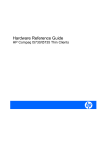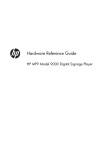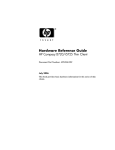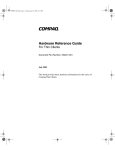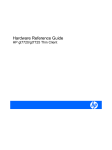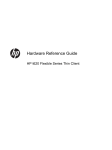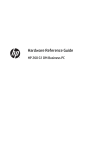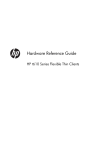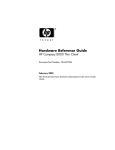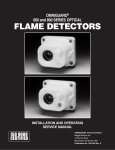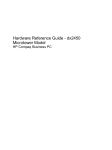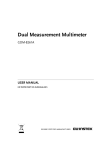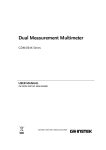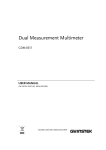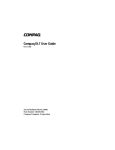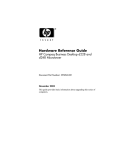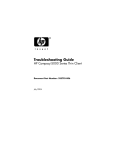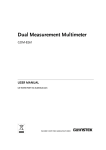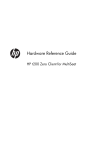Download HP t5135 User's Manual
Transcript
Hardware Reference Guide HP Compaq t5135/t5530 Thin Clients © Copyright 2006 Hewlett-Packard Development Company, L.P. The information contained herein is subject to change without notice. Microsoft and Windows are trademarks of Microsoft Corporation in the U.S. and other countries. The only warranties for HP products and services are set forth in the express warranty statements accompanying such products and services. Nothing herein should be construed as constituting an additional warranty. HP shall not be liable for technical or editorial errors or omissions contained herein. This document contains proprietary information that is protected by copyright. No part of this document may be photocopied, reproduced, or translated to another language without the prior written consent of Hewlett-Packard Company. Hardware Reference Guide Business PCs First Edition (January 2007) Document Part Number: 437853–001 About This Book WARNING! Text set off in this manner indicates that failure to follow directions could result in bodily harm or loss of life. CAUTION Text set off in this manner indicates that failure to follow directions could result in damage to equipment or loss of information. NOTE Text set off in this manner provides important supplemental information. ENWW iii iv About This Book ENWW Table of contents 1 Product features Standard features ................................................................................................................................. 1 Front panel components ....................................................................................................................... 2 Secure USB compartment ports ........................................................................................................... 2 Rear panel components ....................................................................................................................... 3 Installing the stand ............................................................................................................................... 4 Removing the stand ............................................................................................................................. 4 Using the keyboard .............................................................................................................................. 5 Windows Logo Key .............................................................................................................. 6 Additional function keys ....................................................................................................... 6 Special mouse functions ...................................................................................................................... 6 Serial number location .......................................................................................................................... 7 2 Hardware changes General hardware installation sequence .............................................................................................. 8 Installing USB devices in the secure USB compartment .................................................................... 10 Removing the secure USB compartment cover ................................................................. 10 Installing the USB device ................................................................................................... 11 Replacing the secure USB compartment cover ................................................................. 11 Replacing the battery ......................................................................................................................... 12 Removing the side access panel and metal side cover ..................................................... 12 Removing and replacing the battery .................................................................................. 13 Replacing the metal side cover and side access panel ..................................................... 13 External drives .................................................................................................................................... 14 3 Specifications 4 Security provisions Securing the thin client ....................................................................................................................... 17 5 Mounting the thin client HP Quick Release .............................................................................................................................. 18 Supported mounting options .............................................................................................. 20 Non-supported mounting option ........................................................................................ 22 6 Thin client operation Routine thin client care ....................................................................................................................... 23 Supported orientations ....................................................................................................................... 23 ENWW v Non-supported orientation .................................................................................................................. 24 7 Electrostatic discharge Preventing electrostatic damage ........................................................................................................ 26 Grounding methods ............................................................................................................................ 27 8 Shipping information Shipping preparation .......................................................................................................................... 28 Important service repair information ................................................................................................... 28 vi ENWW 1 Product features Standard features Thank you for purchasing an HP Compaq thin client. We hope you have years of use from our t5135 or t5530 thin clients. Our goal is to provide you with award-winning clients that are easy to deploy and manage with the power and reliability you expect. HP has partnered with Altiris to manage HP Compaq thin clients. Altiris Deployment Solution is a leadingedge tool to help with quick deployment and for ongoing management of the thin clients in your organization. Each HP Compaq thin client is recognized by the Altiris Deployment Solution as a supported device. As a result, you need not track license compliancy for each device. For additional information about the Altiris Deployment Solution tool, refer to the Altiris Deployment Solution insert that shipped with the thin client and the Deployment Solution User Guide that is available at http://www.altiris.com/documentation. The next sections describe the features of the thin client. For a complete list of the hardware and software installed on a specific model, visit http://h18004.www1.hp.com/products/thinclients/index.html and search for a specific thin client model. The following features are common to all HP thin clients: ● no moving parts ● no hard drives or diskette drives ● 5-minute setup time ● central deployment and management using Altiris Deployment Solution Various options are available for your thin client. For more information about available options, visit the HP Web site at http://h30143.www3.hp.com/configure2.cfm ENWW Standard features 1 Front panel components Figure 1-1 Front panel components (1) Secure USB compartment (5) Line-out (headphone) audio connector (2) Power button (6) Line-in (microphone) connector (3) Flash activity LED (7) Universal serial bus (USB) connectors (2) (4) Power LED * For more information, refer to the model-specific QuickSpecs at http://h18004.www1.hp.com/products/quickspecs/ QuickSpecs_Archives/QuickSpecs_Archives.html Secure USB compartment ports Figure 1-2 Secure USB compartment ports The secure USB compartment allows you to use two USB devices in a secured location. 2 Chapter 1 Product features ENWW Rear panel components Figure 1-3 Rear panel components (1) Cable lock slot (5) PS/2 connectors (2) (2) Ethernet RJ-45 connector (6) Monitor connector (3) Parallel connector (7) Serial connector (4) Universal serial bus (USB) connectors (4) (8) Power connector For more information, see the model-specific QuickSpecs at http://h18004.www1.hp.com/products/quickspecs/ QuickSpecs_Archives/QuickSpecs_Archives.html ENWW Rear panel components 3 Installing the stand To install the stand: 1. Turn unit upside down. 2. Locate the slots on the bottom of the unit into which the tabs on the stand fit. 3. Insert the tabs into the slots (1), and then slide the stand about 1/2–inch toward the back of the unit until it locks into place (2). Figure 1-4 Installing the stand Removing the stand To remove the stand: 1. Turn unit upside down. 2. Press the tab (1), and then slide the stand about 1/2–inch toward the front of the unit and lift the stand off the unit (2). Figure 1-5 Removing the stand 4 Chapter 1 Product features ENWW Using the keyboard Figure 1-6 Keyboard features (1) Caps Lock key Activates/deactivates the Caps Lock feature. (2) Scroll Lock key Activates/deactivates the Scroll Lock feature. (3) Num Lock key Activates/deactivates the Num Lock feature. (4) Ctrl key Use in combination with another key; its function depends on the application software you are using. (5) Windows Logo Key1 Opens the Start menu in Microsoft Windows. Use in combination with other keys to perform other functions. For more information, see Windows Logo Key. (6) Alt key Use in combination with another key; its function depends on the application software you are using. (7) Application key1 Similar to the right mouse button, opens pop-up menus in a Microsoft Office application. May perform other functions in other software applications. (8) Editing keys Includes the following: Insert, Home, Page Up, Delete, End, and Page Down. Hold Ctrl and Alt while pressing Delete to restart the thin client. 1 Available in select geographic regions. ENWW Using the keyboard 5 Windows Logo Key Use the Windows Logo Key in combination with other keys to perform certain functions available in Windows operating systems. Windows Logo Key + Tab Switch between open items. Windows Logo Key + e Open My Computer. Windows Logo Key + f Search for a file or folder. Windows Logo Key + Ctrl + f Search for computers. Windows Logo Key + m Minimize all windows. Windows Logo Key + Shift + m Undo minimize all. Windows Logo Key + Break Display the System Properties dialog box. Windows Logo Key + r Open the Run dialog box. Additional function keys The following key combinations also work on HP Compaq t5135/t5530 thin clients: Alt + Esc Cycles through minimized applications. Alt + Tab Cycles through open applications. Alt + Shift + Tab Switches to the previous session. Special mouse functions Most software applications support the use of a mouse. The functions assigned to each mouse button depend on the software applications you are using. 6 Chapter 1 Product features ENWW Serial number location Every thin client includes a unique serial number located as shown in the following illustration. Have this number available when contacting HP customer service for assistance. Figure 1-7 Serial number location ENWW Serial number location 7 2 Hardware changes General hardware installation sequence To ensure the proper installation thin client hardware components: 1. Back up any data, if necessary. 2. If the thin client is powered on: a. Turn the unit and any other attached devices off. b. Disconnect the power cord from the wall outlet. c. Disconnect any external devices or cables. WARNING! To reduce the risk of personal injury from electrical shock and/or hot surfaces, be sure to disconnect the power cord from the wall outlet and allow the internal system components to cool before touching. WARNING! To reduce the risk of electrical shock, fire, or damage to the equipment, do not plug telecommunications or telephone connectors into the network interface controller (NIC) receptacles. CAUTION Static electricity can damage the electronic components of the thin client or optional equipment. Before beginning these procedures, ensure that you are discharged of static electricity by briefly touching a grounded metal object. See Preventing electrostatic damage for more information. 3. Remove any hardware that you will replace. 4. Install or replace equipment. For removal and replacement procedures, see the following sections: ❑ Replacing the battery ❑ Installing USB devices in the secure USB compartment NOTE Option kits include more detailed installation instructions. 8 5. Reconnect any external devices and power cords. 6. Turn on the monitor, the thin client, and any devices you want to test. 7. Load any necessary drivers. Chapter 2 Hardware changes ENWW NOTE You can download select hardware drivers from HP at http://www.hp.com/country/ us/eng/support.html. 8. ENWW Reconfigure the thin client, if necessary. General hardware installation sequence 9 Installing USB devices in the secure USB compartment The secure USB compartment allows you to install two USB devices in a secure location inside of the thin client. Along with providing a hidden location, the secure USB compartment can be locked by the optional security cable lock. CAUTION The ambient temperature inside of the secure USB compartment can reach up to 55°C in worst case conditions. Make sure the specifications for any device you install in the compartment indicate the device can tolerate a 55°C ambient environment. NOTE In addition to following these instructions, follow the detailed instructions that accompany the accessory you are installing. Before beginning the installation process, review General hardware installation sequence for procedures you should follow before and after installing or replacing hardware. Removing the secure USB compartment cover Use the following procedure to remove the secure USB compartment cover. WARNING! Before removing the secure USB compartment cover, ensure that the thin client is turned off and the power cord is disconnected from the electrical outlet. To remove the secure USB compartment cover: 1. On rear of the thin client, remove the screw that secures the compartment cover to the unit (1). 2. On the front of the unit, push the compartment cover about 1/2–inch toward the back of the unit (2). 3. Remove the cover from the unit by first lifting the rear (screw side) of the cover, and then lifting the cover off the unit (3). Figure 2-1 Removing the secure USB compartment cover 10 Chapter 2 Hardware changes ENWW Installing the USB device ▲ Insert the USB device into the USB port in the secure USB compartment. See the following illustration for the location of the ports in the secure USB compartment. Figure 2-2 Secure USB compartment port location Replacing the secure USB compartment cover To replace the secure compartment cover: 1. Place the cover on top of the unit so it is offset about 1/2–inch toward the rear of the unit, allowing the tabs on the cover to align and insert into the slots on the chassis (1). 2. Slide the cover toward the front of the unit until it locks in place and the cover is flush with the front panel of the chassis (2). 3. Replace the screw (3). Figure 2-3 Replacing the secure compartment cover To remove USB devices from the secure compartment, reverse the previous procedures. ENWW Installing USB devices in the secure USB compartment 11 Replacing the battery Before beginning the replacement process, review General hardware installation sequence for procedures you should follow before and after installing or replacing hardware. To replace the battery: 1. Remove the side access panel and metal side cover 2. Remove and replace the battery 3. Replace the metal side cover and side access panel Removing the side access panel and metal side cover WARNING! Before removing the side access panel, ensure that the thin client is turned off and the power cord is disconnected from the electrical outlet. To remove the access panel: 1. Remove the secure compartment cover (1). For more information, see Removing the secure USB compartment cover. 2. Remove the two back panel screws that secure the access panel to the chassis (2). 3. Slide the access panel about 1/4–inch toward the front of the unit, and then lift the access panel up and off the unit (3). Figure 2-4 Removing the side access panel To remove the metal side cover: 1. 12 Remove the three screws that secure the metal side cover to the chassis (1). Chapter 2 Hardware changes ENWW 2. Lift the metal side cover up and off the unit (2). Figure 2-5 Removing the metal side cover Removing and replacing the battery To remove and replace the battery: 1. Locate the battery on the system board. 2. Pull back on the clip (1) that is holding the battery in place, and then remove the battery (2). Figure 2-6 Removing and replacing the internal battery 3. Insert the new battery and position the clip back into place. Replacing the metal side cover and side access panel To replace the metal side cover: 1. ENWW Place the metal side cover on the chassis, making sure to align the screw holes in the cover with the holes in the chassis. Replacing the battery 13 2. Insert and tighten the three screws. Figure 2-7 Replacing the metal side cover To replace the access panel: 1. Place the access panel on the side of the unit, offset about 1/2–inch toward the front of the unit (1). 2. Slide the panel toward the rear of the unit until it locks into place (2). 3. Replace the two screws that secure the access panel to the chassis (3). Figure 2-8 Replacing the side access panel External drives Various external USB drives are available as options for the t5135/t5530. For more information about these drives, visit http://www.hp.com/products/thinclientsoftware, or refer to the instructions that accompany the option. For more information about available options, visit the HP Web site at http://h30143.www3.hp.com/ configure2.cfm 14 Chapter 2 Hardware changes ENWW 3 Specifications Table 3-1 HP Compaq t5135/t5530 Thin Client Dimensions Width (front to back) 7.31 in. 18.57 cm Height (top to bottom) 7.31 in 18.57 cm Depth 2.06 in. 5.24 cm Approximate Weight 2.9 lb 1.3 kg 50° to 104° F 10° to 40° C -22° to 140° F -30° to 60° C Temperature Range (fanless design)* Operating** (max. rate of change is 10° C per hour or 18° F per hour) Nonoperating (max. rate of change is 20° C per hour or 36° F per hour) *Specifications are at sea level with altitude derating of ** The operating temperature range when the thin client 1° C/300m (1.8° F/1000ft) to a maximum of 3Km (10,000ft), is attached to a flat panel using the HP Quick Release with no direct, sustained sunlight. Upper limit may be limited is 50° to 95°F (10° to 35°C). by the type and number of options installed. Relative Humidity (non-condensing) Operating 10–90% 10–90% 5–95% 5–95% (max. wet bulb temperature is 28° C or 84.2° F) Nonoperating (max. wet bulb temperature is 38.7° C or 101.6° F) Maximum Altitude (unpressurized) 10,000 ft Operating 3048 m (max. allowed rate of change is 457m per minute or 1500 ft per minute) Nonoperating 30,000 ft 9144 m (max. allowed rate of change is 457m per minute or 1500 ft per minute) Power Supply 100–240 VAC 100–240 VAC 50–60 Hz 50–60 Hz Operating Voltage Range Rated Line Frequency ENWW 15 Table 3-1 HP Compaq t5135/t5530 Thin Client (continued) 16 Power Output (maximum) 40 W 40 W Rated Output Current (maximum) 3.3 A 3.3 A Chapter 3 Specifications ENWW 4 Security provisions Securing the thin client The HP Compaq t5135/t5530 thin client is designed to accept a security cable lock. This cable lock prevents unauthorized removal of the thin client, as well as locking the secure compartment. To order this option, visit the HP Web site at http://h30143.www3.hp.com/configure2.cfm. 1. Locate the cable lock slot on the back panel. 2. Insert the cable lock into the slot, and then use the key to lock it. Figure 4-1 Securing the thin client ENWW Securing the thin client 17 5 Mounting the thin client HP Quick Release The HP Compaq t5135/t5530 thin client incorporates four mounting points on each side of the unit. These mounting points follow the VESA (Video Electronics Standards Association) standard, which provides industry-standard mounting interfaces for Flat Displays (FDs), such as flat panel monitors, flat displays, and flat TVs. The HP Quick Release connects to the VESA-standard mounting points, allowing you to mount the thin client in a variety of orientations. NOTE When mounting, use the 10 mm screws supplied with the Quick Release Kit. Figure 5-1 HP Quick Release To order this option, visit the HP Web site at http://h30143.www3.hp.com/configure2.cfm 18 Chapter 5 Mounting the thin client ENWW To use the HP Quick Release with a VESA-configured thin client: 1. Using four 10 mm screws included in the mounting device kit, attach one side of the HP Quick Release to the thin client as shown in the following illustration. Figure 5-2 Connecting the HP Quick Release to the thin client 2. Using four screws included in the mounting device kit, attach the other side of the HP Quick Release to the device to which you will mount the thin client. Make sure the release lever points upward. Figure 5-3 Connecting the HP Quick Release to another device ENWW HP Quick Release 19 3. Slide the side of the mounting device attached to the thin client (1) over the other side of the mounting device (2) on the device on which you want to mount the thin client. An audible 'click' indicates a secure connection. Figure 5-4 Connecting the thin client NOTE When attached, the HP Quick Release automatically locks in position. You only need to slide the lever to one side to remove the thin client. CAUTION To ensure proper function of the HP Quick Release and a secure connection of all components, make sure both the release lever on one side of the mounting device and the rounded opening on the other side face upward. Supported mounting options The following illustrations demonstrate some of the supported and not supported mounting options for the mounting bracket. ● You can mount a thin client between a flat panel monitor and the wall. Figure 5-5 Thin client mounted with flat panel on wall 20 Chapter 5 Mounting the thin client ENWW ● You can mount the thin client on the back of a flat panel monitor stand. Figure 5-6 Thin client mounted on back of monitor stand ● You can mount the thin client on a wall. Figure 5-7 Thin client mounted on wall ● ENWW You can mount the thin client under a desk. HP Quick Release 21 Figure 5-8 Thin client mounted under desk Non-supported mounting option CAUTION Mounting a thin client in an non-supported manner could result in failure of the HP Quick Release and damage to the thin client and/or other equipment. Do not mount the thin client on a flat panel monitor stand, between the panel and the stand. Figure 5-9 Unsupported mounting position - thin client between stand and monitor 22 Chapter 5 Mounting the thin client ENWW 6 Thin client operation Routine thin client care Use the following information to properly care for your thin client: ● Never operate the thin client with the outside panel removed. ● Keep the thin client away from excessive moisture, direct sunlight, and extreme heat and cold. For information about the recommended temperature and humidity ranges for the thin client, see Specifications. ● Keep liquids away from the thin client and keyboard. ● Turn off the thin client and wipe the exterior with a soft, damp cloth as needed. Using cleaning products may discolor or damage the finish. Supported orientations HP supports the following orientations for the thin client. CAUTION You must adhere to HP-supported orientations to ensure your thin clients function properly. ● You can place the thin client vertically using the supplied stand. Figure 6-1 Vertical orientation ● ENWW You can lay the thin client horizontally on its rubber feet. Routine thin client care 23 Figure 6-2 Horizontal orientation ● You can lay the thin client under a monitor stand with at least one inch of clearance. Figure 6-3 Under monitor stand Non-supported orientation HP does not support the following orientation for the thin client. CAUTION Non-supported placement of thin clients could result in operation failure and/or damage to the devices. CAUTION Thin clients require proper ventilation to maintain operating temperature. Do not put thin clients in drawers or other sealed enclosures. Thin clients require proper ventilation to maintain operating temperatures. 24 Chapter 6 Thin client operation ENWW Figure 6-4 Do not put thin clients in drawers or other sealed enclosures ENWW Non-supported orientation 25 7 Electrostatic discharge A discharge of static electricity from a finger or other conductor may damage system boards or other static-sensitive devices. This type of damage may reduce the life expectancy of the device. Preventing electrostatic damage To prevent electrostatic damage, observe the following precautions: 26 ● Avoid hand contact by transporting and storing products in static-safe containers. ● Keep electrostatic-sensitive parts in their containers until they arrive at static-free workstations. ● Place parts on a grounded surface before removing them from their containers. ● Avoid touching pins, leads, or circuitry. ● Always be properly grounded when touching a static-sensitive component or assembly. Chapter 7 Electrostatic discharge ENWW Grounding methods There are several methods for grounding. Use one or more of the following methods when handling or installing electrostatic-sensitive parts: ● Use a wrist strap connected by a ground cord to a grounded Thin Client chassis. Wrist straps are flexible straps with a minimum of 1 megohm +/- 10 percent resistance in the ground cords. To provide proper grounding, wear the strap snug against the skin. ● Use heelstraps, toestraps, or bootstraps at standing workstations. Wear the straps on both feet when standing on conductive floors or dissipating floor mats. ● Use conductive field service tools. ● Use a portable field service kit with a folding static-dissipating work mat. If you do not have any of the suggested equipment for proper grounding, contact an HP authorized dealer, reseller, or service provider. NOTE For more information about static electricity, contact an HP authorized dealer, reseller, or service provider. ENWW Grounding methods 27 8 Shipping information Shipping preparation Follow these suggestions when preparing to ship the thin client: 1. Turn off the thin client and external devices. 2. Disconnect the power cord from the electrical outlet, then from the thin client. 3. Disconnect the system components and external devices from their power sources, then from the thin client. 4. Pack the system components and external devices in their original packing boxes or similar packaging with sufficient packing material to protect them. NOTE For environmental nonoperating ranges, see Specifications. Important service repair information In all cases, remove and safeguard all external options before returning the thin client to HP for repair or exchange. In countries that support customer mail-in repair by returning the same unit to the customer, HP makes every effort to return the repaired unit with the same internal memory and flash modules that were sent. In countries that do not support customer mail-in repair by returning the same unit to the customer, all internal options should be removed and safeguarded in addition to the external options. The thin client should be restored to the original configuration before returning it to HP for repair. 28 Chapter 8 Shipping information ENWW


































